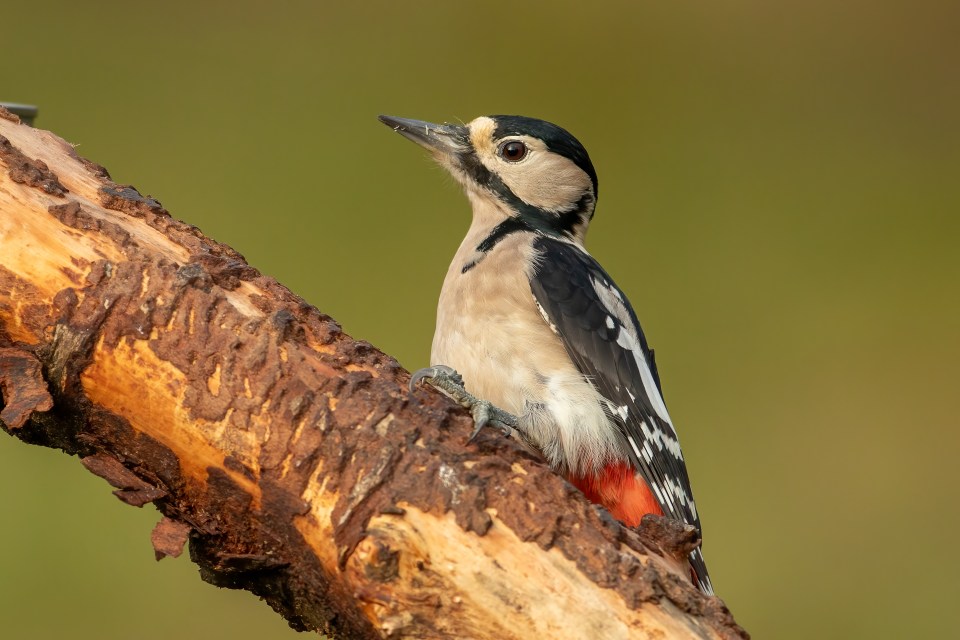Species Guide: Great Spotted Woodpecker (Dendrocopos major)
Family: Picidae
Appearance
Despite their distinctive & predominantly black-and-white pattern with flashes of bright red, you will likely hear the Great Spotted Woodpecker before you see them. They are extremely vocal, yet they are also quite shy woodland birds. This article covers everything you need to know about the Great Spotted Woodpecker.
DIET
The Great Spotted Woodpecker is equipped with a strong beak. They can hammer their beak into holes in tree bark and extract insect larvae using their long tongues. They will also eat spiders, beetles, and caterpillars as well as prey on the eggs of smaller birds! The Great Spotted Woodpecker will also eat nuts and seeds as well as fat from garden bird feeders.

HABITAT
The Great Spotted Woodpeckers’ natural habitat is broadleaved woodland, but they are adaptable animals and have inhabited a variety of habitats.

Ad Space
Behavior
They have a very distinctive bounce or dipping pattern to their flight. They are about the size of a blackbird but slimmer in the body. They spend a lot of time clinging to vertical branches, and can often be spotted shuffling around the trees to hide themselves from prying eyes. If you look carefully, particularly at broadleaf trees, you may see signs of the woodpecker where they have pecked holes into the bark.
The males and females are virtually identical, except that the male has a bright red flash of color on the back of his head. They prefer to nest in old trees and can use their strong beaks to peck away at the tree to create holes large enough to bring up their young. You can often hear them pecking away at the trees as the sound tends to echo. As well as drumming at the tree to find food and build nests, it is also used as a signal by males to audibly mark their territories.
There is a misconception promoted across the web including several major ornithological organizations, that Great Spotted Woodpeckers have shock-absorbing skulls! Unfortunately, this isn’t supported by science.2 Great Spotted Woodpeckers have evolved through natural selection a mechanism that allows the energy from hammering to be transmitted through their skulls without taking damage due to the small size and shape of their brains3
Both the male and female take on the job of excavating a nest site, which can take up to 6 weeks to complete! Both birds take turns incubating the clutch of up to 6 eggs, which takes 14-16 days to hatch and then up to 24 days to fledge. Adults live up to 12 years in the wild.

Biometrics4
Adults are up to 24cm in length with an impressive wingspan of up to 27 cm. They weigh up to 90g. It is estimated that there are up to 280,000 Great Spotted Woodpeckers in the British Isles. Their population has increased significantly in the last 50 years and is thought to be a combination of the availability of standing dead wood for nesting sites, less competition from other bird species (it is thought that this may be predominantly starlings), the availability of supplemental food from bird feeders, as well as climate change.
NATURAL PREDATORS
The Goshawk and Sparrowhawk are their main predators in the wild.
CONSERVATION STATUS
The Great Spotted Woodpecker (Dendrocopos major) numbers have increased year on year partially as a consequence of climate change, and also credited to the abundance of standing dead wood.
U.K.
Conservation Status

Global
Conservation Status

Related Articles




Ad Space
Citations
- By Vicpeters – Own work, CC BY-SA 3.0, [Accessed 17/10/2025] ↩︎
- Physiology: Woodpecker skulls are not shock absorbers [Accessed 17/10/2025] ↩︎
- Physics Today: Why Woodpeckers Dont Get Concussions [Accessed 17/10/2025] ↩︎
- Featherbase [Accessed 17/10/2025] ↩︎







